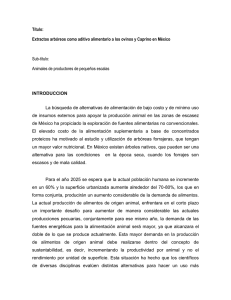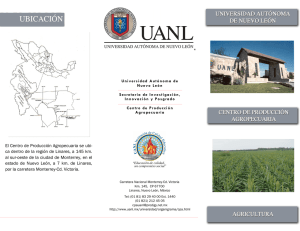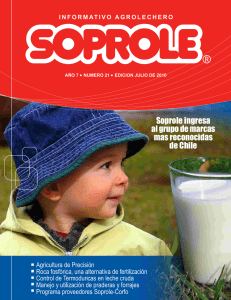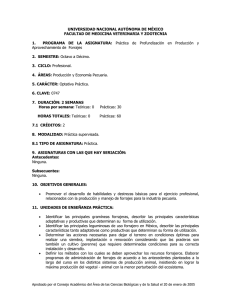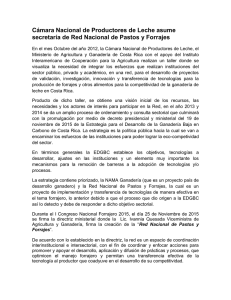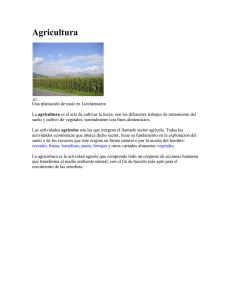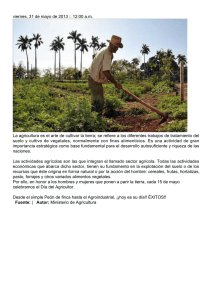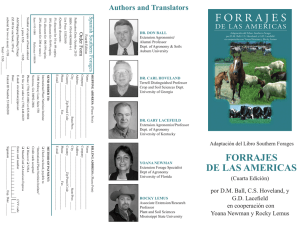Español
Anuncio
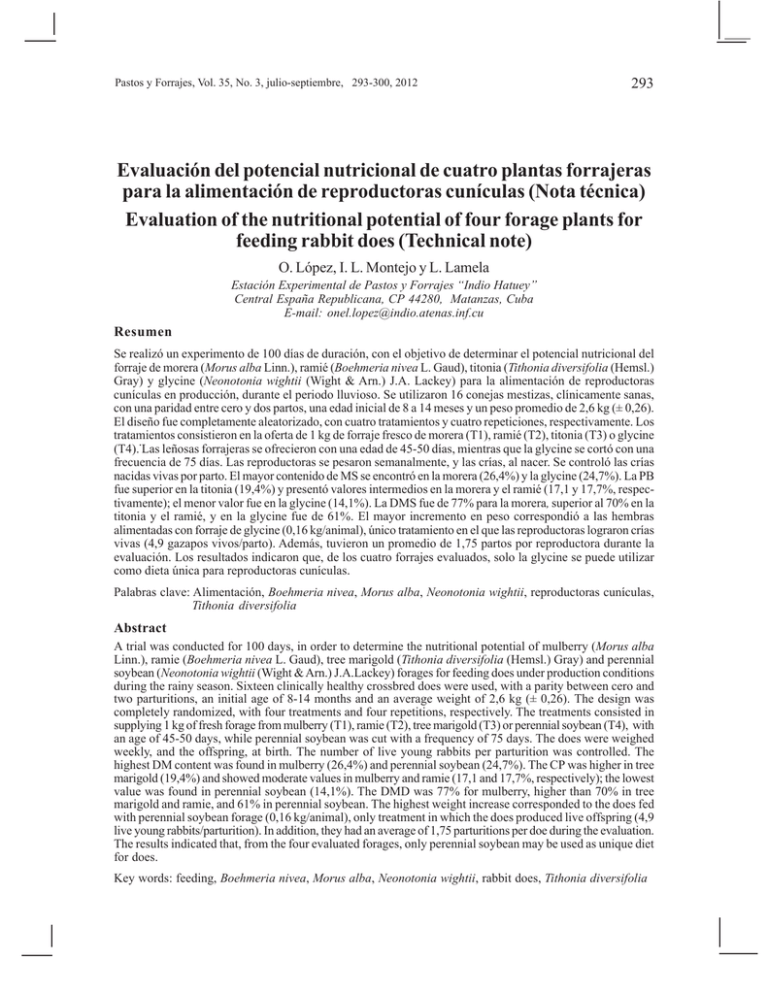
Pastos y Forrajes, Vol. 35, No. 3, julio-septiembre, 293-300, 2012 293 Evaluación del potencial nutricional de cuatro plantas forrajeras para la alimentación de reproductoras cunículas (Nota técnica) Evaluation of the nutritional potential of four forage plants for feeding rabbit does (Technical note) O. López, I. L. Montejo y L. Lamela Estación Experimental de Pastos y Forrajes “Indio Hatuey” Central España Republicana, CP 44280, Matanzas, Cuba E-mail: onel.lopez@indio.atenas.inf.cu Resumen Se realizó un experimento de 100 días de duración, con el objetivo de determinar el potencial nutricional del forraje de morera (Morus alba Linn.), ramié (Boehmeria nivea L. Gaud), titonia (Tithonia diversifolia (Hemsl.) Gray) y glycine (Neonotonia wightii (Wight & Arn.) J.A. Lackey) para la alimentación de reproductoras cunículas en producción, durante el periodo lluvioso. Se utilizaron 16 conejas mestizas, clínicamente sanas, con una paridad entre cero y dos partos, una edad inicial de 8 a 14 meses y un peso promedio de 2,6 kg (± 0,26). El diseño fue completamente aleatorizado, con cuatro tratamientos y cuatro repeticiones, respectivamente. Los tratamientos consistieron en la oferta de 1 kg de forraje fresco de morera (T1), ramié (T2), titonia (T3) o glycine . (T4). Las leñosas forrajeras se ofrecieron con una edad de 45-50 días, mientras que la glycine se cortó con una frecuencia de 75 días. Las reproductoras se pesaron semanalmente, y las crías, al nacer. Se controló las crías nacidas vivas por parto. El mayor contenido de MS se encontró en la morera (26,4%) y la glycine (24,7%). La PB fue superior en la titonia (19,4%) y presentó valores intermedios en la morera y el ramié (17,1 y 17,7%, respectivamente); el menor valor fue en la glycine (14,1%). La DMS fue de 77% para la morera, superior al 70% en la titonia y el ramié, y en la glycine fue de 61%. El mayor incremento en peso correspondió a las hembras alimentadas con forraje de glycine (0,16 kg/animal), único tratamiento en el que las reproductoras lograron crías vivas (4,9 gazapos vivos/parto). Además, tuvieron un promedio de 1,75 partos por reproductora durante la evaluación. Los resultados indicaron que, de los cuatro forrajes evaluados, solo la glycine se puede utilizar como dieta única para reproductoras cunículas. Palabras clave: Alimentación, Boehmeria nivea, Morus alba, Neonotonia wightii, reproductoras cunículas, Tithonia diversifolia Abstract A trial was conducted for 100 days, in order to determine the nutritional potential of mulberry (Morus alba Linn.), ramie (Boehmeria nivea L. Gaud), tree marigold (Tithonia diversifolia (Hemsl.) Gray) and perennial soybean (Neonotonia wightii (Wight & Arn.) J.A.Lackey) forages for feeding does under production conditions during the rainy season. Sixteen clinically healthy crossbred does were used, with a parity between cero and two parturitions, an initial age of 8-14 months and an average weight of 2,6 kg (± 0,26). The design was completely randomized, with four treatments and four repetitions, respectively. The treatments consisted in supplying 1 kg of fresh forage from mulberry (T1), ramie (T2), tree marigold (T3) or perennial soybean (T4), with an age of 45-50 days, while perennial soybean was cut with a frequency of 75 days. The does were weighed weekly, and the offspring, at birth. The number of live young rabbits per parturition was controlled. The highest DM content was found in mulberry (26,4%) and perennial soybean (24,7%). The CP was higher in tree marigold (19,4%) and showed moderate values in mulberry and ramie (17,1 and 17,7%, respectively); the lowest value was found in perennial soybean (14,1%). The DMD was 77% for mulberry, higher than 70% in tree marigold and ramie, and 61% in perennial soybean. The highest weight increase corresponded to the does fed with perennial soybean forage (0,16 kg/animal), only treatment in which the does produced live offspring (4,9 live young rabbits/parturition). In addition, they had an average of 1,75 parturitions per doe during the evaluation. The results indicated that, from the four evaluated forages, only perennial soybean may be used as unique diet for does. Key words: feeding, Boehmeria nivea, Morus alba, Neonotonia wightii, rabbit does, Tithonia diversifolia 294 Pastos y Forrajes, Vol. 35, No. 3, julio-septiembre, 293-300, 2012 Introducción Introduction En Cuba, los productores cunículas han utilizado la glycine como alimento base, tanto en las dietas de las reproductoras como de los animales de ceba, en ambos casos con buenos resultados productivos (López, Montejo y Lamlea 2011). No obstante, existen otras plantas no leguminosas con potencial para la producción de follaje, las cuales tienen un valor nutricional similar –y en muchos casos superior– al de las leguminosas. Las más conocidas y estudiadas en la alimentación de los monogástricos son Morus alba Linn., Tithonia diversifolia (Hemsl.) Gray y Boehmeria nivea (L.) Gaud. La titonia es un arbusto multipropósito que puede resistir cortes repetidos y producir una considerable cantidad de biomasa de excelente valor nutritivo (Ramírez et al., 2010), con una degradabilidad ruminal de la MS de un 70% a las 48 h (Medina et al., 2009). El ramié es una planta que se produce en climas tropicales y subtropicales y se adapta bien a suelos ligeramente ácidos (Garnica, Restrepo, y Parra, 2010). Aunque no tiene un elevado valor nutricional, debido a su alto contenido en fibra, presenta una buena producción de biomasa, de bajo costo, y una aceptable concentración de proteína bruta, lo que posibilita su inclusión en la dieta de animales monogástricos. La morera es una especie forrajera con elevada producción de biomasa (Noda, 2006) y de excelente calidad nutricional. El contenido de PB fluctúa entre 15 y 25% y la digestibilidad in situ de la MS es superior al 80% (Boschini, 2001). Posee una alta palatabilidad y un elevado consumo por los animales (Sánchez, 2001). Aunque estas plantas se han utilizado ampliamente en la alimentación cunícula con resultados alentadores (López y Montejo, 2005; López, Montejo y Lamela, 2011), todavía se desconoce si tienen el potencial nutritivo adecuado para constituir la única dieta en esta especie animal. De ahí que el objetivo de este estudio fuera determinar el potencial nutricional del forraje de morera, ramié, titonia y glycine, como dieta única para la alimentación de reproductoras cunículas en producción. In Cuba, rabbit producers have used perennial soybean as basic feedstuff in the diets of does as well as fattening animals, in both cases with good productive results (López et al., 2011). However, there are other non-leguminous plants with potential for foliage production, which have a high nutritional value similar to –and in many cases higher than- that of legumes. The most widely known and studied for feeding monogastric animals are Morus alba Linn., Tithonia diversifolia (Hemsl.) Gray, and Boehmeria nivea (L.) Gaud. Tree marigold is a multipurpose shrub which can withstand repeated cuttings and produce a remarkable amount of biomass with excellent nutritional value (Ramírez et al., 2010), and with a rumen DM degradability of 70% after 48 h (Medina et al., 2009). Ramie is a plant produced in tropical and subtropical climates and it adapts well to slightly acid soils (Garnica et al., 2010). Although its nutritional value is not high, because of its high fiber content, it shows good biomass production, with low cost, and an acceptable crude protein concentration, which allows its inclusion in the diet of monogastric animals. Mulberry is a forage species with high biomass production (Noda, 2006) and excellent nutritional quality. The CP content fluctuates between 15 and 25% and the in situ DM digestibility is higher than 80% (Boschini, 2001). It has high palatability and high intake by the animals (Sánchez, 2001). Although these plants have been widely used in rabbit feeding with encouraging results (López and Montejo, 2005; López, Montejo and Lamela, 2011), it is still unknown whether they have the adequate nutritional potential for constituting the sole diet of this animal species. Hence the objective for this study was to determine the nutritional potential of mulberry, ramie, tree marigold and perennial soybean, forages as sole diet for feeding does under production conditions. Experimental methodology Location of the experimental area. The work was conducted at the small animal unit of Pastos y Forrajes, Vol. 35, No. 3, julio-septiembre, 293-300, 2012 Metodología experimental Ubicación del área experimental. El trabajo se realizó en el módulo de animales menores de la Estación Experimental de Pastos y Forrajes “Indio Hatuey” –del municipio Perico, provincia Matanzas– durante 100 días de evaluación, correspondientes al periodo lluvioso y de más altas temperaturas en el año. La media de temperatura fue de 25,7°C, y la humedad relativa, de 86,3%. Animales y tratamientos. Para no afectar demasiado los indicadores productivos de la unidad de producción, se utilizaron solo 16 reproductoras mestizas, clínicamente sanas, con una paridad entre cero y dos partos, una edad entre 8 y 14 meses al inicio del experimento, y un peso promedio de 2,6 kg (± 0,26). Cada una de las hembras se asignó aleatoriamente a uno de los cuatro tratamientos, hasta completar un total de cuatro reproductoras por tratamiento. Se empleó un diseño completamente aleatorizado. Alojamiento. Los animales fueron alojados individualmente en jaulas de alambre galvanizado, de 75 cm de largo por 75 cm de ancho y 40 cm de altura, provistas con comederos y bebederos de barro. La nave tenía techo de fibrocemento, paredes de malla peerlet y piso de cemento con fosos debajo de las jaulas, y estaba situada a una altura de 40 cm sobre el suelo. Alimentación. Las hembras consumieron una dieta constituida solo por 1 kg de forraje fresco de morera (T1), ramié (T2), titonia (T3) o glycine (T4). El alimento se ofreció dividido en dos raciones: una, en el horario de la mañana (8:309:30 a.m.), y la otra, en la tarde (3:30-4:20 p.m.). Análisis de laboratorio. Se tomaron muestras representativas de cada uno de los forrajes y se enviaron al laboratorio para determinar su composición química. Los indicadores medidos fueron: MS, ceniza, proteína bruta y calcio, que se estimaron por las técnicas descritas por la AOAC (1995), y el fósforo, por el método colorimétrico con la utilización de un espectrofotómetro UV/V. Las fracciones fibrosas (FND, FAD, lignina y celulosa) se analizaron por los procedimientos referidos por Goering y van Soest (1970); mientras que la 295 the Experimental Station of Pastures and Forages “Indio Hatuey” –Perico municipality, Matanzas province- during 100 days of evaluation, corresponding to the rainy season and the period with the highest temperatures of the year. The temperature mean was 25,7ºC and the relative humidity, 86,3%. Animals and treatments. In order to avoid affecting too much the productive indicators of the production unit, only 16 clinically healthy crossbred rabbit does were used, which parity was between cero and two parturitions, they were 8-14 months old at the beginning of the trial, and had an average weight of 2,6 kg (± 0,26). Each doe was randomly assigned to one of the four treatments, until completing a total of four does per treatment. A completely randomized design was used. Housing. The animals were individually housed in galvanized wire cages, 75 cm long, 75 cm wide and 40 cm high, with earthenware drinking and feeding troughs. The shed had a fiber-cement roof, chain-link fence walls and cement floor with pits beneath the cages, and it was placed at a height of 40 cm above the soil. Feeding. The does were fed with 1 kg of fresh forage from mulberry (T1), ramie (T2), tree marigold (T3) or perennial soybean (T4). The feedstuff was supplied divided into two rations: one in the morning (8:30-9:30 a.m.) and the other one, in the afternoon (3:30-4:20 p.m.). Laboratory analyses. Representative samples were taken from each forage plant and sent to the laboratory to determine its chemical composition. The measured indicators were: DM, ash, crude protein and calcium, which were estimated through the techniques described by the AOAC (1995), and phosphorus, by means of the colorimetric method using a UV/V spectrophotometer. The fibrous fractions (NDF, ADF, lignin and cellulose) were analyzed through the procedures referred by Goering and Van Soest (1970); while the in vitro DM digestibility was estimated using the method proposed by Kesting (1977). Animal management. The directed mating was used, in which the does were presented to 296 Pastos y Forrajes, Vol. 35, No. 3, julio-septiembre, 293-300, 2012 digestibilidad in vitro de la MS se estimó por el método de Kesting (1977). Manejo zootécnico. Se utilizó la monta dirigida, en la cual las reproductoras se presentaron a los sementales a partir de los 20 días posparto. Los apareamientos se observaron por el personal técnico encargado de esa actividad y se realizaron dos servicios por celo en el horario de la mañana (8:20-8:50 a.m.) y la tarde (4:00-4:20 p.m.). Los nidales se colocaron en el interior de las jaulas a los 27 días posmonta; estos contenían heno de bermuda, para evitar la humedad. Los partos se realizaron de forma espontánea y sin atención veterinaria, e inmediatamente se procedió al conteo y pesaje individual de las crías. Mediciones. Las hembras se pesaron semanalmente durante todo el periodo de evaluación, y las camadas, al nacer, con una balanza digital de 10 kg y un error de 10 g. Procesamiento de la información. A partir de los registros individuales de las reproductoras, los datos controlados fueron: identificación, fecha de monta, fecha de parto y crías nacidas por reproductora. Estos se incluyeron en una hoja de cálculo de Microsoft Excel para facilitar el procesamiento de la información, y se calcularon los siguientes indicadores: total de nacidos, promedio de crías nacidas vivas por parto y peso promedio al nacer. Resultados y Discusión En la tabla 1 se muestra la composición bromatológica de los alimentos utilizados en el estudio. Se encontraron marcadas diferencias en el contenido de MS de los distintos forrajes: la morera presentó el mayor valor (26,4%), y la titonia, el menor (14,3%). En el caso de la PB, el valor más alto se encontró en la titonia (19,4%), el más bajo en la glycine (15,5%) y los intermedios en la morera y el ramié (17,1 y 17,7%, respectivamente). El contenido de PB en la morera fue similar al informado por Albert, Díaz, Urra y Molina (2012) para la fracción comestible de su forraje (17,4%), en un suelo Ferralítico Rojo lixiviado de montaña, con una precipitación media anual de 2 000 mm. the bucks since 20 days after parturition. The matings were observed by the technical personnel in charge of that activity and two services per estrus occurred in the morning (8:20-8:50 a.m.) and the afternoon (4:00-4:20 p.m.). The nests were placed inside the cages 27 days after mating; they contained Bermuda grass hay, to prevent moisture. The parturitions occurred spontaneously and without veterinary attention, and the young rabbits were immediately counted and weighed. Measurements. The does were weekly weighed throughout the evaluation period, and the litters were weighed at birth, by means of a digital 10-kg scale, with an error of 10 g. Information processing. From the individual records of the does, the controlled data were: identification, mating date, parturition date and young ones born per doe. They were included in a Microsoft Excel calculation sheet to facilitate the information processing, and the following indicators were calculated: total born, average of young rabbits born alive per parturition and average weight at birth. Results and Discussion Table 1 shows the bromatological composition of the feedstuffs used in the study. Remarkable differences were found in the DM content of the different forages: mulberry showed the highest value (26,4%), and tree marigold, the lowest value (14,3%). In the case of CP, the highest value was found in tree marigold (19,4%), the lowest in perennial soybean (15,5%) and the moderate ones were found in mulberry and ramie (17,1 and 17,7%, respectively). The CP content in mulberry was similar to the one reported by Albert, Díaz, Urra and Molina (2012) for the edible fraction of its forage (17,4%), on a mountain lixiviated Ferralitic Red soil, with mean annual rainfall of 2 000 mm. The CP concentration in ramie was similar to the one reported by Gabbi et al. (2004) for the hay of this forage plant in Brazil, in a subtropical climate with regular rainfall regime. The CP content in tree marigold was similar to that reported by Ramírez et al. (2010) in plants Pastos y Forrajes, Vol. 35, No. 3, julio-septiembre, 293-300, 2012 Tabla 1. Composición bromatológica de los forrajes (% MS) Table 1. Bromatological composition of the forages (% DM) Indicador MS Cenizas PB DMS FND FAD Celulosa Lignina Ca P Morera 26,4 13,4 17,1 77,0 34,1 18,5 10,9 6,7 2,25 0,31 Forrajes Ramié Titonia 16,7 14,3 21,0 16,5 17,7 19,4 73,1 71,5 57,2 36,2 42,4 32,8 20,7 26,0 17,8 8,3 3,76 1,55 0,42 0,32 Glycine 24,7 8,2 15,5 60,8 66,8 43,2 31,8 12,1 1,35 0,25 La concentración de PB en el ramié fue similar a la informada por Gabbi et al. (2004) para el heno de esta forrajera en Brasil, en un clima subtropical con régimen regular de lluvias. El contenido de PB en la titonia fue similar al reportado por Ramírez et al. (2010) en plantas cosechadas a los 42 días, durante la estación seca (20,1%); además, fue superior al informado por Souza (2007) en plantas en la etapa de prefloración (12,4%), sembradas con un marco de plantación de 0,5 por 0,75 m, en un suelo Argisol rojo-amarillento. En la glycine, la PB (18%) fue inferior a la informada por Delgado, La O y Chongo (2007) para el follaje de plantas cosechadas en un suelo Ferralítico Rojo, en condiciones climáticas similares a las de este estudio. El comportamiento del peso promedio final y el incremento en peso de las reproductoras 297 harvested after 42 days, during the dry season (20,1%); in addition, it was higher than the one reported by Souza (2007) in plants during the preflowering stage (12,4%), sown with a 0,5 x 0,75 m planting frame, on a red-yellowish Argisol soil. In perennial soybean, CP (18%) was higher than that found by Delgado, La O and Chongo (2007) for the foliage of plants harvested on a Ferralitic red soil, under similar climate conditions to the ones in this study. The performance of the average final weight and weight increase of the does during the evaluation is shown in table 2. The animals which achieved higher increase in this indicator were the ones fed with perennial soybean, proving the role of fiber in the diet of this species, because this forage showed the highest NDF concentration. Mulberry is a shrub which shows antinutritional factors that affect the digestive physiology of monogastric animals when it is excessively consumed (López and Montejo, 2005). Likewise, it shows high CP content and high apparent DM and CP degradability (Nieves et al., 2006), which could affect negatively the energy-protein ratio of the ratio. On the other hand, tree marigold shows a high CP content and a low DM percentage, which might affect the DM intake and reduce the energy-protein ratio of the diet, because it has a relatively low NDF concentration, similar to the report by Mahecha and Rosales (2005). Ramie is a plant with a high CP value and a high lignin concentration, which may negatively affect feed intake, DM digestibility and the energy-protein balance of the ration (Acosta, Tabla 2. Comportamiento del peso promedio final y el incremento en peso durante el periodo de evaluación Table 2. Performance of average final weight and weight increase during the evaluation period 298 Pastos y Forrajes, Vol. 35, No. 3, julio-septiembre, 293-300, 2012 durante la evaluación se presentan en la tabla 2. Los animales que lograron un mayor incremento en este indicador fueron los alimentados con glycine, lo que demuestra el papel de la fibra en la dieta de esta especie, ya que este forraje manifestó la mayor concentración de FND. La morera es una planta arbustiva que presenta factores antinutricionales que afectan la fisiología digestiva de los monogástricos cuando se consume en exceso (López y Montejo, 2005). Asimismo, muestra un elevado contenido de PB y alta degradabilidad aparente de la MS y la PB (Nieves et al., 2006), lo cual pudiera afectar de forma negativa la relación energía-proteína de la ración. Por su parte, la titonia presenta un alto contenido de PB y un bajo porcentaje de MS, lo que puede afectar el consumo de MS y reducir la proporción energía-proteína en la dieta, ya que posee una concentración de FND relativamente baja, similar a lo reportado por Mahecha y Rosales (2005). El ramié es una planta con un alto valor de PB y una elevada concentración de lignina, que pueden afectar negativamente el consumo de alimento, la digestibilidad de la MS y el balance energía-proteína de la ración (Acosta, Rosales, Márquez-Araque y Monsalve, 1997). En sentido general, las ganancias fueron bajas, lo que estuvo influenciado también por el balance energético negativo que sufren las hembras durante la lactación y la consiguiente movilización de las reservas corporales en este periodo (FortunLamothe, 2006). En la tabla 3 se presenta el comportamiento de los indicadores productivos de las conejas, por tratamiento. En las reproductoras alimentadas con morera, ramié y titonia se obtuvieron –como promedio– 3, 1 y 4 gazapos por camada, respectivamente; pero en los tres casos todas las crías nacieron muertas. Esto pudo estar relacionado con la alta concentración de proteína de dichos forrajes (superior a un 17% en los tres casos) y la elevada digestibilidad in vitro de la MS (por encima del 70%), así como los valores más bajos de FND en relación con la dieta basada en glycine; ello pudo afectar el balance energético de las reproductoras, si se tiene en cuenta que la Rosales, Márquez-Araque y Monsalve, 1997). In general, the gains were low, which was also influenced by the negative energy balance undergone by does during lactation and the subsequent mobilization of body reserves in this period (Fortun-Lamothe, 2006). Table 3 shows the performance of the productive indicators of the does, per treatment. In the does fed mulberry, ramie and tree marigold, 3, 1 and 4 young rabbits were obtained per litter, respectively, -as average-; but in the three cases the offspring were born dead. This could be related to the high protein concentration of such forages (higher than 17% in the three of them) and the high in vitro DM digestibility (over 70%), as well as the lower values of NDF as compared to the diet based on perennial soybean; this could affect the energy balance of does, if it is considered that fiber constitutes an important energy source in the diet for pregnant does (Schoknecht, 1997), especially when there are no concentrate feeds available. In addition, it has a positive effect on digestive health, animal welfare and the reproductive performance of the animals (Johnson, Noll, Rentería and Shurson, 2003). However, the does fed with perennial soybean had an average of 6,8 young rabbits born per litter, from which 4,9 (72%) were alive. These results are lower than those reported by Planinc et al. (2011) when using a feeding system based on commercial concentrate ad libitum, in which they found a litter size –at birth- of 7,8 young rabbits, and 7,3 born alive. In the does of the treatments which feeding was based on forage ligneous plants only one parturition was obtained during the experimental period, with 0% of the young rabbits alive. This could have been related to an energy deficit in the animals that consumed these diets, leading to the mobilization of their body reserves and, thus, the affectation of fertility and reproductive efficiency (Fortun-Lamothe, 2006). The animals fed with perennial soybean forage showed a better performance, because they had seven parturitions during the evaluation, which represented 1,75 parturitions per doe. Besides, they gave birth to 48 young rabbits, from which 71% (34) were alive. 299 Pastos y Forrajes, Vol. 35, No. 3, julio-septiembre, 293-300, 2012 Tabla 3. Efecto del forraje en el comportamiento de los indicadores productivos de las conejas Table 3. Effect of forage on the performance of productive indicators in does Tratamiento T1 (morera) T2 (ramié) T3 (titonia) T4 (glycine) Promedio por parto Nacidos Nacidos vivos 3,0 ± 0,00 0,0 ± 0,00 1,0 ± 0,00 0,0 ± 0,00 4,0 ± 0,00 0,0 ± 0,00 6,8 ± 3,10 4,9 ± 2,60 fibra constituye una importante fuente de energía en la dieta para las conejas gestantes (Schoknecht, 1997), especialmente cuando no disponen de concentrados. Además, tiene un efecto positivo en la salud digestiva, el bienestar animal y el comportamiento reproductivo de los animales (Johnson, Noll, Rentería y Shurson 2003). Sin embargo, las conejas alimentadas con glycine tuvieron una media de 6,8 gazapos nacidos por camada, de los cuales 4,9 (72%) estaban vivos. Estos resultados son inferiores a los reportados por Planinc et al. (2011) al emplear un sistema de alimentación basado en concentrado comercial ad libitum, en el cual encontraron un tamaño de la camada –al nacer– de 7,8 gazapos, y un número de crías nacidas vivas por camada de 7,3. En las reproductoras de los tratamientos cuya alimentación se basó en leñosas forrajeras se obtuvo un solo parto durante el periodo experimental, con un 0% de gazapos vivos. Esto pudo estar relacionado con un déficit de energía en los animales que consumieron estas dietas, lo que condujo a la movilización de sus reservas corporales y, con ello, a la afectación de la fertilidad y la eficiencia reproductiva (Fortun-Lamothe, 2006). Los animales alimentados con forraje de glycine mostraron un mejor comportamiento, pues tuvieron siete partos durante la evaluación, lo cual representó 1,75 partos por reproductora. Además, parieron 48 gazapos, de los cuales el 71% (34) estaban vivos. Conclusiones Se comprobó que las leñosas forrajeras morera, ramié y titonia no pueden constituir la dieta Conclusions It was proven that the forage ligneous plants mulberry, ramie and tree marigold cannot constitute the only diet of does, because they are incapable of reproducing when fed only such forages. The productive performance of the does was acceptable when they were fed perennial soybean forage, with which 4,9 live rabbits per parturition were obtained as average. --End of the English version-- única de las reproductoras cunículas, ya que estas son incapaces de reproducirse cuando se sustentan solo con dichos forrajes. El comportamiento productivo de las conejas mestizas fue aceptable cuando se alimentaron con forraje de glycine, con el cual se obtuvieron –como promedio– 4,9 gazapos vivos por parto. Referencias bibliográficas Acosta, Iraida de; Rosales, J.; Márquez-Araque, Alis & Monsalve, D. 1997. Evaluación energética y digestibilidad del ramio (Boehmeria nivea) en aves. Rev. Fac. Agron. (Universidad del Zulia). 14 :517 Albert, Anayansi; Díaz, D.; Urra, O. & Molina, Yelien. 2012. Evaluación del comportamiento productivo de conejos (Oryctolagus cuniculus) Lin. en crecimiento alimentados con forrajes de especies arbóreas. Memorias II Convención Internacional Agrodesarrollo 2012. [CD-ROM]. Estación Experimental de Pastos y Forrajes “Indio Hatuey”, Matanzas, Cuba. AOAC. 1995. Official methods of analysis. Ass. Off. Agric. Chem. 16th ed. Washington, DC. Boschini, C. 200. Degradabilidad en situ de la materia seca, proteína y fibra del forraje de morera (Morus Alba). Agronomía Mesoamericana. 12(1):79 Delgado, Denia; La O, O. & Chongo, Bertha. 2007. Composición bromatológica y degradabilidad ruminal in situ de leguminosas tropicales con perspectivas de uso en los sistemas productivos ganaderos. Rev. cub. Cienc. agríc. 41 (4):343 Fortun-Lamothe, L. 2006. Energy balance and reproductive performance in rabbit does. Animal Reproduction Science. 93:1 Gabbi, A.M. et al. 2004. Increasing levels of ramie (Boehmeria nivea) hay on the diets of fattening rabbits. Proceedings 8th World Rabbit Congress. Puebla, México. p. 125 Garnica, J.D.; Restrepo, J.A. & Parra, J.E. 2010. Digestibilidad total de materia seca y proteína 300 Pastos y Forrajes, Vol. 35, No. 3, julio-septiembre, 293-300, 2012 cruda de Boehmeria nivea L. Gaud en cerdos en crecimiento. Livestock Research for Rural Development. 22 (10). Disponible en: www.lrrd.org/ lrrd22/10/garn22185.htm. [27/7/2012] Goering, H.K. & van Soest, P.J. 1970. Forage fiber analysis. Agricultural handbook. U.S. Department of Agriculture. No. 379. Washington, USA. Johnson, L.J.; Noll, S.; Renteria, A. & Shurson, J. 2003. Feeding by-products high in concentration of fiber to nonruminants. Third National Symposium on Alternative feeds for livestock and poultry held. Kansas City, MO, USA. Disponible en: http:// wcroc.cfans.umn.edu/prod/groups/cfans/@pub/ @cfans/@wcroc/documents/asset/ cfans_asset_185066.pdf. [18/8/2012] Kesting, V. 1977. Uber neure Ergebnisse einer vereinfachten in vitro-Methode zur zchatzung der verdaulichkeit der organischen substanz ohne pan sensaft. 1. Mittelilung. Arch. Tierernahrung, Berlin. Bd. 28, S. 491- 497. López, O. & Montejo, I.L. 2005. Evaluación de indicadores productivos en conejas mestizas alimentadas con morera y otros forrajes. Pastos y Forrajes. 28:163 López, O.; Montejo, I.L. & Lamela, L. 2011. Evaluación de indicadores productivos en conejas mestizas con una dieta basada en forraje y pienso criollo. Pastos y Forrajes. 34:97 Mahecha, Liliana & Rosales, M. 2005. Valor nutricional del follaje de botón de oro (Tithonia diversifolia [Helms.] Gray) en la producción animal en el trópico. Livestock Research for Rural Development. 17 (9). Disponible en: http://www.lrrd.org/lrrd17/9/ mahe17100.htm. [15/4/2009] Medina, María G. et al. 2009. Variables morfo-estructurales y de calidad de la biomasa de Tithonia diversifolia en la etapa inicial de crecimiento. Zootecnia Tropical. 27 (2):121 Nieves, D. et al 2006. Digestibilidad de nutrientes del follaje de morera (Morus alba) en conejos de engorde. Revista Científica. XVI (4):364 Noda, Yolai. 2006. Influencia de la frecuencia y la altura de corte en la producción y composición bromatológica de Morus alba (Linn.). Tesis presentada en opción al título académico de Master en Pastos y Forrajes. Estación Experimental de Pastos y Forrajes “Indio Hatuey”. Matanzas, Cuba. 95 p. Planinc, Martina; Kermauner, Adja; Malovrh, Špela & Kovaè, Milena. 2011. Growth and mortality of suckling rabbits. Agriculturae Conspectus Scientificus. 76 (4):305 Ramírez, U. et al. 2010. Effect of diet inclusion of Tithonia diversifolia on feed intake, digestibility and nitrogen balance in tropical sheep. Agroforestry System. 80:295 Sánchez, M.D. 2001. Mulberry as animal feed in the world. In: Mulberry for animal feeding in China. (Eds. L. Jian, C. Yuyin, M. Sánchez and L. Xingmeng). Hangzhou, China. p. 1 Schoknecht, P.A. 1997. Swine nutrition: nutrient usage during pregnancy and early postnatal growth, an introduction. Journal of Animal Science. 75 (10):2705 Souza, O.F. de 2007. Influência do espaçamento e da época de corte na produção de biomassa e valor nutricional de Tithonia diversifolia (Hemsl.) Gray. Dissertação apresentada para obtenção do título de Mestre em Agronomia-Área de Concentração em Fitotecnia. Faculdade de Ciências Agrárias da Universidade de MaríliaUNIMAR. Brasil. 43 p. Recibido el 13 de febrero del 2012 Aceptado el 20 de junio del 2012
